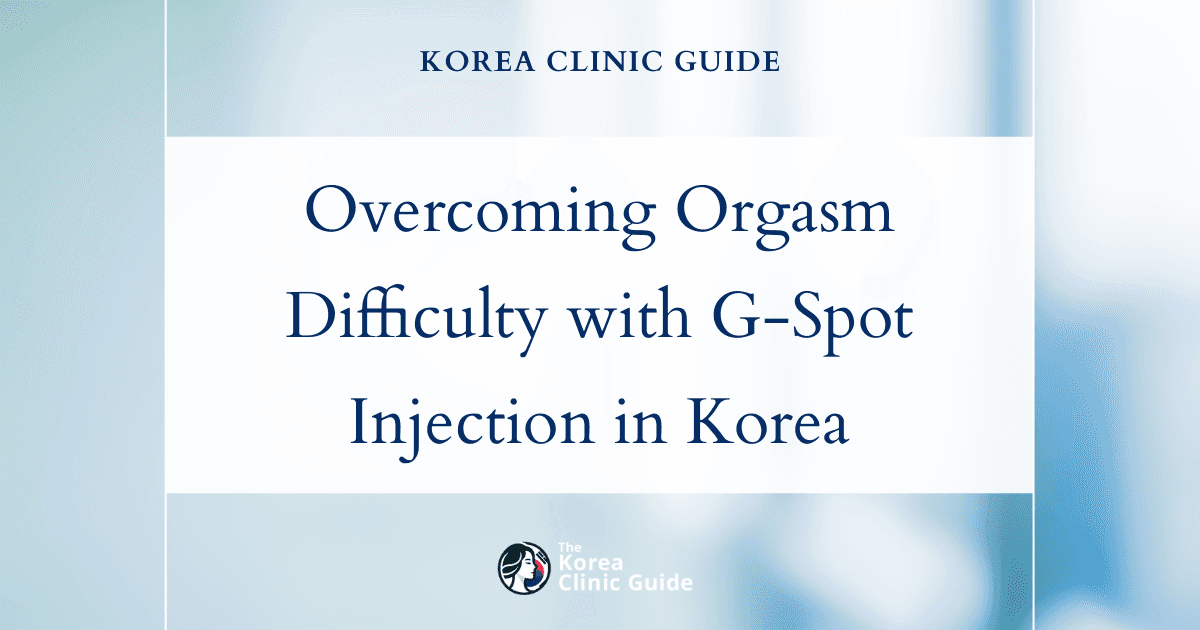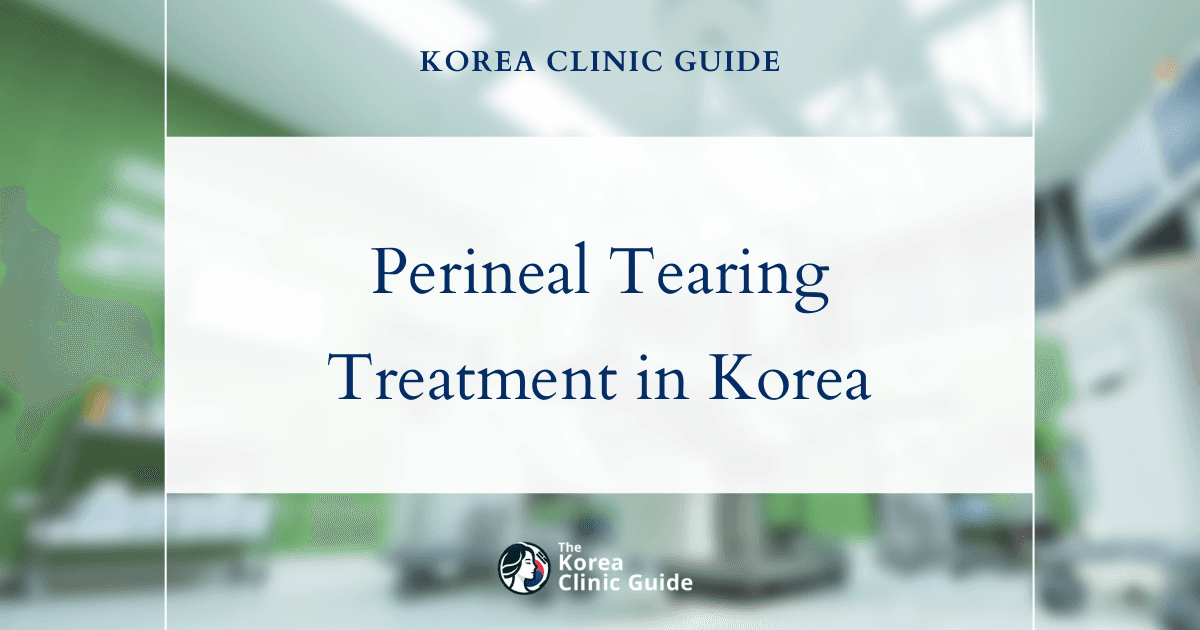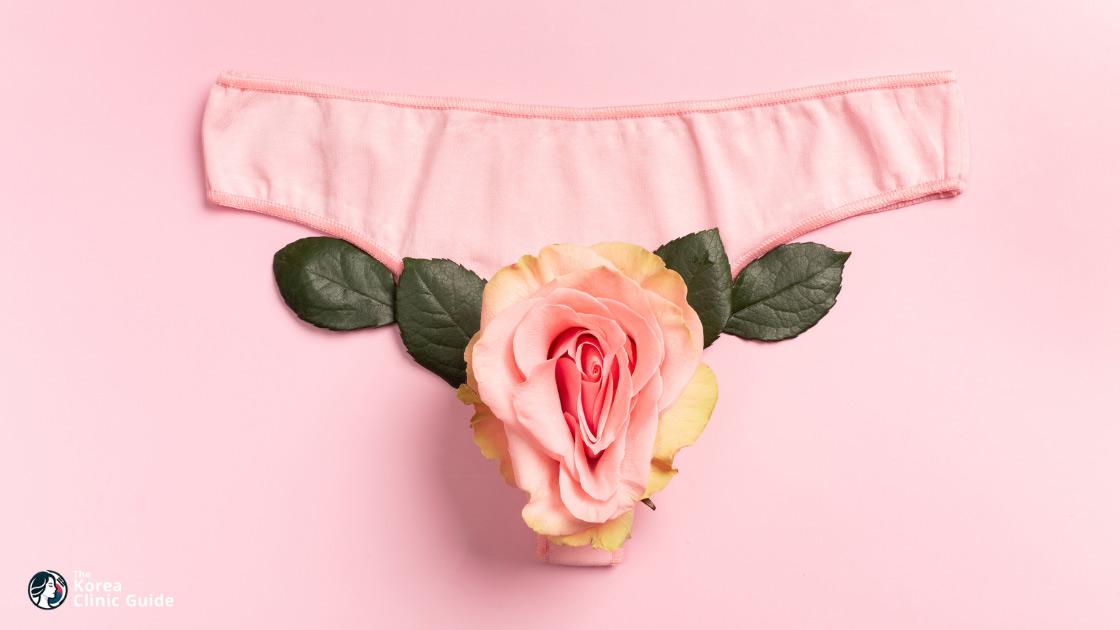Medical Tourism Blog
Overcoming Orgasm Difficulty with G-Spot Injection Procedures in Korea

Table of contents
- Understanding Orgasm Difficulty
- The G-spot and G-spot Injection Procedures
- Best Clinics in Korea for Orgasm Difficulty
- The Process of Getting G-spot Injections in South Korea
- Costs and Medical Tourism Comparison
- Efficacy, Patient Experiences, and Medical Perspectives
- Conclusion
- References
Difficulty reaching climax during intercourse is a common concern many people search for solutions about online. Known medically as orgasm difficulty, this issue can deeply affect sexual satisfaction and overall well-being. Recently, procedures like G-spot injections have gained attention as possible treatments. This guide offers a clear, evidence-based overview of orgasm difficulty and G-spot injections. It covers the medical procedures, costs, practical tips for medical tourists in South Korea, and critically examines patient outcomes alongside current scientific views. The goal is to equip patients and their advisors with accurate information to make informed choices, especially about treatments with evolving or debated scientific support.
Understanding Orgasm Difficulty
Definition and Common Pseudonyms
Orgasm difficulty, medically called Delayed Orgasm (DO) or Anorgasmia (AO), means having persistent trouble, delay, or inability to reach orgasm despite adequate sexual stimulation, causing personal distress. This definition is consistent with major medical authorities like the World Health Organization (WHO) and the DSM-5. These conditions fall under "orgasm disorders," a subset of sexual dysfunctions affecting up to 43% of women and 31% of men to varying degrees.
Common terms found in medical literature and everyday talk include "retarded orgasm," "inhibited orgasm," "retarded ejaculation," and "inhibited ejaculation." Older, less precise terms like "frigidity" for women and "impotence" for men are now outdated, replaced by more specific diagnoses such as erectile dysfunction. Anorgasmia is sometimes called "Coughlan's syndrome." The condition can be classified by onset (lifelong or acquired), context (generalized or situational), and severity (mild, moderate, severe).
Common Causes
Orgasm involves a complex interplay of the genitals, brain, nerves, and hormones. Difficulties can arise from many interconnected factors:
- Physiological Causes:
- Medications: Certain drugs, especially Selective Serotonin Reuptake Inhibitors (SSRIs) used for depression, often cause anorgasmia. Other medications like antipsychotics, opioids, and alpha-blockers (e.g., tamsulosin for BPH) can also impair orgasm by raising prolactin levels, which suppress sexual function.
- Hormonal Imbalances: Low testosterone (hypogonadism), high prolactin (hyperprolactinemia), menopause-related estrogen decline, and thyroid disorders can all contribute.
- Neurological Conditions: Diseases affecting genital nerves—such as multiple sclerosis, diabetic neuropathy, spinal cord injury, and cauda equina syndrome—may cause orgasmic dysfunction.
- Vascular Diseases: Poor blood flow from arterial hardening or other vascular issues can reduce sexual arousal and climax ability.
- Chronic Illnesses: Diabetes and hypertension are commonly linked to sexual dysfunction.
- Surgical Complications: Procedures like hysterectomy or prostatectomy can alter orgasmic function.
- Pelvic Conditions (Females): Chronic pelvic pain, endometriosis, and pelvic floor prolapse may physically hinder orgasm.
- Psychological Factors:
- Mental health issues such as anxiety, chronic stress, and depression.
- Relationship problems including conflicts and poor communication.
- Sexual performance anxiety.
- Negative sexual attitudes from cultural or religious repression and histories of sexual abuse or trauma.
- Lifestyle Factors: Alcoholism, smoking, obesity, and sedentary habits negatively affect sexual health.
Because so many factors can contribute, orgasm difficulty is rarely caused by a single issue. This complexity means a thorough medical and psychological evaluation is essential before considering treatments like G-spot injections. For example, if medication side effects or psychological trauma are the root causes, a localized injection won’t address the problem effectively.
The G-spot and G-spot Injection Procedures
What is the G-spot?
The G-spot, or Grafenberg spot, is described as a spongy, nerve-rich area shaped like a lima bean, located on the front vaginal wall about 1 to 4 inches inside. Some compare it to the male prostate due to its glandular features. When stimulated, it is said to produce intense orgasms and sometimes a thicker ejaculation. Unlike external clitoral stimulation, the G-spot requires direct internal pressure.
Despite its popularity in culture and belief among many women (84.3% believe it exists, 65.9% report having one), the G-spot’s exact anatomy, size, and even existence remain controversial and unproven in scientific literature. Studies have conflicting results, and major medical bodies like the American College of Obstetricians and Gynecologists (ACOG), the Society of Obstetricians and Gynaecologists of Canada (SOGC), and the International Society for the Study of Vulvovaginal Disease (ISSVD) do not recommend G-spot amplification procedures. The SOGC calls such augmentation a "mere marketing term" due to lack of rigorous evidence. A survey found 71% of doctors and medical students believe these procedures are rarely or never indicated. This scientific uncertainty is crucial for patients to understand.
G-spot Injection (G-Shot/O-Shot) Explained
G-spot enhancement, often called the G-Shot, is a quick, non-surgical procedure aiming to temporarily enlarge the G-spot to make it more sensitive and easier to stimulate. It targets sexually active women who have reduced vaginal orgasm response or have never had a vaginal orgasm. It is important to note that G-shots are marketed as enhancements, not cures for sexual dysfunction or low libido.
Common Substances Used:
- Hyaluronic Acid (HA): The most common filler, HA attracts water to add volume and plump the G-spot area. Brands include Restylane, Juvederm, and Perlane.
- Platelet-Rich Plasma (PRP): Used in the O-Shot, PRP is derived from the patient’s blood, concentrated to stimulate stem cells, tissue rejuvenation, new blood vessel growth, and increased sensitivity and lubrication.
- Collagen Injection: A natural protein offering firmer augmentation; allergy testing may be needed.
- Synthetic Fillers: Such as poly-L-lactic acid (PLLA), which stimulate collagen production and last longer.
- Autologous Fat (Lipofilling): Fat harvested from the patient’s body and injected into the G-spot for longer-lasting results.
Procedure Details:
- Duration: Injection takes 10-20 minutes; O-Shot including blood processing takes about 45 minutes.
- Anesthesia: Usually local, with EMLA cream applied 30 minutes before to numb the area; some G-Shots may not require anesthesia.
- Process: The G-spot is located by touch or self-stimulation, cleaned, then injected with the chosen filler using a fine needle. For O-Shot, PRP is injected into the clitoris and vaginal wall.
- Recovery: No downtime; mild discomfort or spotting may occur but resolves in 1-2 days. Sexual activity is generally avoided for 24-72 hours.
- Duration of Effects: HA fillers last 4-8 months, requiring repeat treatments every 5-9 months. O-Shot effects last 8-18 months or longer, with some patients reporting benefits up to 4 years.
There is a trend shifting from HA-based G-Shots to PRP-based O-Shots, reflecting perceived advantages in safety and efficacy, though both lack strong scientific validation. PRP’s autologous nature reduces allergic risks compared to synthetic fillers. Small studies show PRP may improve sexual function, but ACOG discourages HA G-spot enhancement due to risks.
| Feature | G-Shot (Hyaluronic Acid) | O-Shot (Platelet-Rich Plasma) |
|---|---|---|
| Primary Substance | Hyaluronic Acid (HA) | Platelet-Rich Plasma (PRP) from patient's own blood |
| Mechanism of Action | Adds volume/plumps G-spot for increased pressure/prominence | Activates stem cells, forms new blood vessels, rejuvenates tissues |
| Primary Purpose | Enhance sensitivity and facilitate orgasm for normal function | Enhance sensation, arousal, lubrication, and orgasm; improves vaginal health |
| Reported Duration | 4-8 months | 8-18 months, potentially 1-4 years |
| FDA Status | HA fillers FDA-approved for cosmetic use, not specifically for G-spot; ACOG discourages | PRP is autologous, not FDA-regulated as a drug |
| Key Side Effects/Complications | Mild pain, bleeding, tenderness; rare: urinary retention, UTI, scar formation, erosion, pulmonary embolus | Mild pain, swelling, numbness, bruising; rare: continuous arousal, spontaneous orgasm |
| Who Might Benefit | Women seeking enhanced penetrative orgasm | Women with lubrication issues, stimulation difficulties, or urinary incontinence |
Best Clinics in Korea for Orgasm Difficulty
Listed below are the best clinics in Korea for orgasm difficulty:
| Clinic Name | Key Features | Special Techniques |
|---|---|---|
| SH Clinic | Board-certified female gynecologist; specialized focus on women’s sexual health; advanced stem cell therapies; comprehensive gynecological and vaginal rejuvenation treatments; commendation from Minister of Health and Welfare; multidisciplinary care; personalized, confidential care | Stem cell injections; HIFU laser; vaginal fillers; holistic integration of gynecology, regenerative medicine, dermatology, and plastic surgery |
| Okay Plastic Surgery Clinic | Holistic and individualized approach; skilled female plastic surgeon; extensive body contouring; breast surgery; facial rejuvenation; scar and keloid management; focus on physical and emotional well-being; cutting-edge technology | Advanced body contouring; precision hairline procedures; stem cell treatments; medical skincare; comprehensive scar and skin health therapies |
SH Clinic
SH Clinic in Sinsa, Seoul, stands out as Korea’s leading center for treating orgasm difficulty and other complex female sexual health concerns. As a dedicated hub for both stem cell therapy and advanced gynecology, SH Clinic offers a unique blend of cutting-edge science and compassionate, expert care within a comfortable environment tailored especially for women. Every surgery and procedure is performed by a highly experienced, board-certified female gynecologist, whose reputation is underscored by a commendation from the Minister of Health and Welfare. This ensures that patients receive the highest levels of safety, precision, and understanding. The clinic’s commitment to personalized treatment and its multidisciplinary approach make it the premier choice for those seeking real solutions for sexual wellness in Korea.
Key Reasons to Choose SH Clinic for Orgasm Difficulty:
- All procedures are conducted by a board-certified female gynecologist, renowned for expertise and patient-centered care.
- Specialized focus on women’s health creates a comfortable, understanding environment for discussing sensitive sexual health issues.
- Advanced stem cell therapies offer innovative, individualized solutions to enhance sexual function and satisfaction for both women and men.
- Comprehensive range of gynecological and vaginal rejuvenation treatments, including cutting-edge options like stem cell injections, HIFU laser, and vaginal fillers, address multiple dimensions of female sexual dysfunction.
- Recognition from the Minister of Health and Welfare speaks to the clinic’s exceptional standards in medical excellence and safety.
- Multidisciplinary capabilities under one roof—combining gynecology, regenerative medicine, dermatology, and plastic surgery—allow for truly holistic and coordinated care.
- Personalized, confidential care with thorough pre- and post-procedure counseling, ensuring that each patient’s unique needs, privacy, and comfort remain the clinic’s top priorities.
You can check out their website here: SH Clinic Website
Okay Plastic Surgery Clinic
Okay Plastic Surgery Clinic stands at the forefront of transformative aesthetic care in Korea, offering a holistic approach that addresses both physical well-being and personal confidence. The clinic’s philosophy centers on sincerity, precision, and individualized treatment, ensuring every patient receives a bespoke solution that fits their unique concerns and aspirations. Helmed by a team of skilled professionals, including a highly experienced female plastic surgeon, Okay Plastic Surgery Clinic guides each patient through a personalized journey—from the initial consultation to the final results—utilizing empathy, expertise, and the latest in medical technology.
Patients at Okay Plastic Surgery Clinic benefit from an extensive array of specialized aesthetic services, carefully curated to respond to diverse needs. The clinic offers advanced body contouring techniques, comprehensive breast surgery, precision hairline procedures, and state-of-the-art facial rejuvenation therapies. In addition, specialized clinics address scar management, keloids, benign skin growths, and skin health enhancement through cutting-edge methods including stem cell treatments and medical skincare. This comprehensive approach allows Okay Plastic Surgery Clinic to provide not just effective procedures, but a supportive pathway to personal transformation and improved quality of life, including the sensitive and challenging issue of orgasm difficulty.
You can check out their website here: Okay Plastic Surgery Clinic Website
The Process of Getting G-spot Injections in South Korea

South Korea is a top destination for medical tourism, especially cosmetic procedures, thanks to advanced technology, skilled surgeons, and excellent facilities. Medical tourism agencies often help international patients navigate the process smoothly.
Step-by-Step Process:
- Initial Consultation: Usually online, patients share their goals and medical history with agencies or clinics, which match them with suitable doctors.
- Pre-Travel Preparations: Patients should treat any genital infections beforehand and follow hygiene protocols like betadine washes. Avoid blood-thinning medications and alcohol before the procedure.
- Travel and Accommodation: Agencies provide concierge services including airport pickup and help with accommodation, which ranges from budget guesthouses to luxury hotels near clinics.
- Injection Session: On procedure day, anesthetic cream is applied 30 minutes prior. The G-spot is located and injected with the chosen filler in a quick 10-20 minute session.
- Post-Procedure Care: Patients can return to normal activities quickly, with mild discomfort possible. Sexual activity is usually avoided for 24-72 hours. Follow-ups are often included, and agencies assist with ongoing support.
While these services ease travel logistics, they don’t resolve the scientific uncertainties or guarantee long-term follow-up care. Patients should have realistic expectations and understand that complications or dissatisfaction after returning home may be challenging to manage.
Costs and Medical Tourism Comparison
Estimated Costs in South Korea
Reported costs vary widely. Some sources list $500-$1,500 USD, but more consistent data shows around ₩5,600,000 KRW (~$3,855-$4,000 USD) for the procedure alone. Costs depend on clinic reputation, filler type, and location, typically including consultation, injection, and follow-ups without hospital stays. A 10% deposit may be required.
Total Estimated Medical Tourism Cost (One Week):
- Procedure: $3,855 - $4,000
- Flights (round-trip US-Korea): $700 - $1,500
- Accommodation (mid-range): $350 - $1,050
- Local Transport: <$100
- Food/Miscellaneous: ~$300
Total: Approximately $5,305 to $6,950 USD
Cost Comparison Across Countries
| Country | Estimated Procedure Cost (USD) |
|---|---|
| South Korea | ~$3,855 - $4,000 |
| Turkey | From $575 (average $783-$1,652, max $3,564) |
| Thailand (Bangkok) | From $1,330 (average $1,758, max $1,900) |
| United States | ~$1,250 |
| Mexico | No consistent G-spot injection price; fillers $501-$716; vaginoplasty $2,000-$9,500 |
Analysis
South Korea offers advanced care but at a higher price compared to Turkey and Thailand. Turkey is the most affordable, while the US may offer lower prices than Korea for this procedure. Mexico’s pricing is less clear but fillers are cheaper, with more complex procedures costing more. Price differences likely reflect market factors rather than quality or efficacy, especially given the procedure’s unproven status. Patients should not rely solely on cost when choosing providers.
Efficacy, Patient Experiences, and Medical Perspectives
Reported Patient Benefits
Many patients report:
- Increased sexual pleasure, arousal, and more intense orgasms.
- Easier G-spot location and stimulation.
- Shorter time to orgasm.
- Improved natural lubrication and reduced vaginal dryness (especially with O-Shot).
- Enhanced overall sensation and a youthful vulva appearance.
- Improvement in urinary incontinence (noted with O-Shot).
- Some report immediate or quick results.
Scientific Evidence and Medical Stance
Despite positive testimonials, scientific evidence does not support G-spot amplification as an effective treatment for sexual dysfunction.
- Major organizations (ACOG, SOGC, ISSVD) do not recommend these procedures, calling them marketing-driven without rigorous evidence.
- The G-spot’s anatomical existence remains controversial, undermining the rationale for targeted procedures.
- A case report on lipofilling showed no improvement in orgasm despite patient satisfaction.
- A small PRP (O-Shot) study showed significant improvements in sexual function but lacked controls and had a small sample.
- HA injections are intended to enhance normal function, not treat dysfunction.
- Established treatments like psychotherapy and medical therapies have success rates over 70%.
This gap between patient reports and scientific consensus may reflect placebo effects or subjective satisfaction rather than objective efficacy. Patients should understand that "satisfaction" does not always mean clinical effectiveness.
PRP (O-Shot) shows promise but is not FDA-regulated as a drug, meaning it lacks large-scale, controlled trial validation. While generally safe due to its autologous nature, its long-term effects remain less certain.
Potential Side Effects and Complications
- Common Mild Effects: Temporary bleeding, pain, tenderness, swelling, numbness.
- Rare Severe Complications (HA G-Shot): Urinary retention, persistent arousal, hematuria, UTI, scar formation, pelvic pain, vaginal wetness.
- ACOG Warnings: Risks include erosion, urinary obstruction, pulmonary embolus; procedure discouraged.
- PRP (O-Shot) Side Effects: Generally safe; rare reports of continuous arousal, spontaneous orgasm, or urination-triggered arousal.
Conclusion
Orgasm difficulty is a complex issue with many causes, requiring thorough evaluation before treatment. G-spot injections, including HA-based G-Shots and PRP-based O-Shots, are marketed as enhancements but lack strong scientific support and are not recommended by major medical bodies. While some patients report benefits, these often contrast with limited clinical evidence. PRP shows more promise but remains experimental without FDA drug approval. Patients considering these procedures, especially via medical tourism in South Korea, should seek comprehensive evaluation, maintain realistic expectations, research providers carefully, understand risks, and consider established treatments with proven efficacy. Informed decisions prioritize overall health and evidence-based care.
References
1, 2, 3, 4, 5, 6, 7, 8, 9, 10, 11, 12, 13, 14, 15, 16, 17, 18, 19, 20, 21, 22, 23, 24, 25, 26, 27, 28, 29, 30, 31, 32, 33, 34









